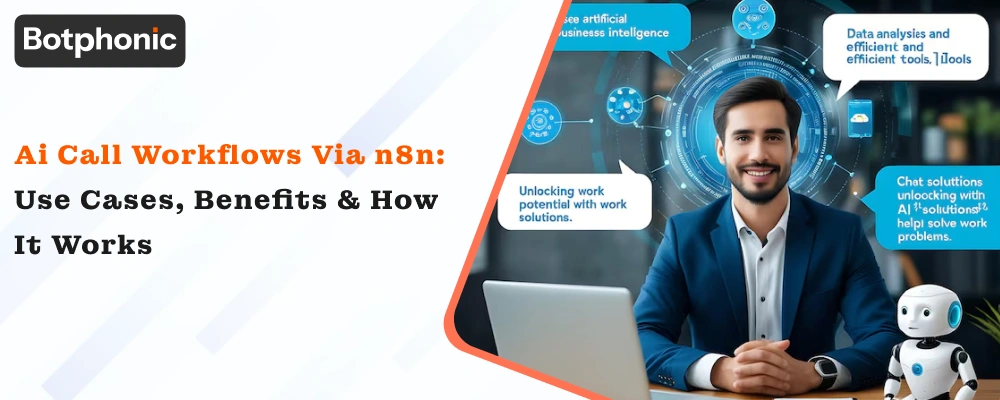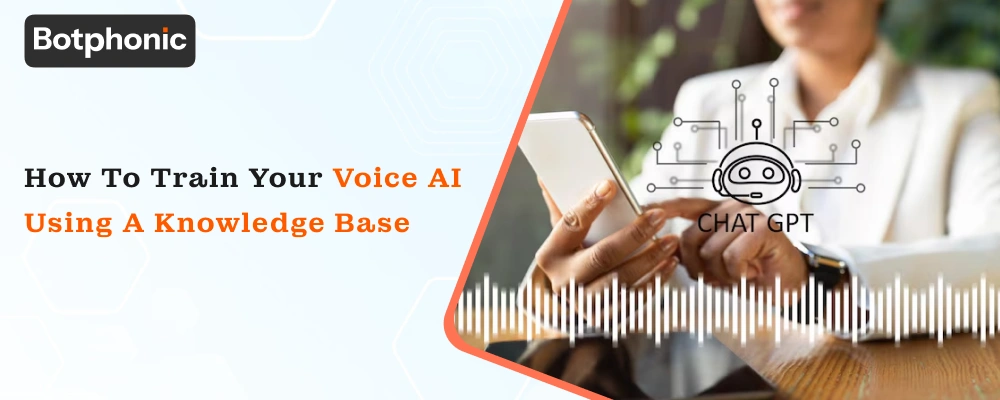
Summarize Content With:
Quick Summary
AI knowledge assistants are transforming how voice interactions happen in call centers. Traditional knowledge bases have become slow, inconsistent, and ill-suited for live conversations. By training voice AI agents optimizing structured, curated knowledge, organizations can easily:
- Deliver real-time and context-aware answers.
- Ensure consistency and accuracy across each call.
- Reduce average handling time (AHT) and improve operational efficiency.
- Empower agents with a digital partner, improving confidence and customer experience.
- Continuously learning and improving via iterative learning and updates.
Training requires auditing, structuring, and chunking content. Moreover, it also includes integrating call data and maintaining a feedback loop for optimizing performance.
Introduction
Let’s start with being honest, cause even in this era of technology, customer calls still sound like they are stuck in 2008. Customers have to wait while being on hold while agents are going through shared knowledge bases. And then they proceed with sharing the exact same response without acknowledging the issue. And everyone just has to pretend that this is “customer support.”
But, truth to be told, they are not lacking empathy but instant access to the right knowledge, which needs to be shared in real-time, in real conversation. Let us introduce you to AI knowledge assistants; they are the next and most acknowledged evolution of intelligent voice technology.
Welcome to the age of voice-first knowledge, and don’t forget to meet your partner: Botphonic AI call assistant.
The Problem with Traditional Knowledge Systems
Traditional knowledge bases are a big library with lots of books that are not categorized. You know that it’s in there, but you really have to go the extra mile just to retrieve some information.
Agents have to actively search through databases, glide through them, and then proceed with interpreting them in their own way to respond promptly. And all this process is happening while the customer is waiting for their query to be resolved.
When we are talking about voice interactions, those 10 seconds for the customer might feel like an eternity. Let’s tell you some harsh facts about this process:
- Agents are spending 25-30% of each call just searching for answers.
- Outdated or irrelevant knowledge always leads to inconsistent experiences across numerous agents.
- And what do you think the result will be? It’s just longer calls, frustrated customers, and lost revenue.
What Is an AI Knowledge Assistant (and How It Differs from a Chatbot)

Let’s get a few things right: every interaction you have with AI is not intelligent.
Many “AI assistants” available in the market are just parrots fed with FAQs; they are just sharing the same pre-written scripts with all the effort of a voicemail menu.
But a voice AI knowledge assistant is just on a whole other level. It’s not pretending to be smart, but it is. And the reason? It’s because it knows how to find the information, understands it, and delivers the information in real time.
Think of it as your agent’s invisible partner, a digital brain that’s whispering the right answer every time.
Here’s the fundamental difference in philosophy:
| Chatbots & Static KBs | AI Knowledge Assistants (like Botphonic) |
| Wait for keywords or triggers | Understand intent and phrasing dynamically |
| Search pre-set scripts or pages | Retrieve verified data in real time |
| Respond from limited options | Summarize and contextualize answers |
| Operate in text-only mode | Work seamlessly across live voice calls |
| Serve the customer directly | Empower agents to serve smarter and faster |
A chatbot is the receptionist you find at the front desk. It’s friendly, helpful, but limited. Whereas a voice AI knowledge assistant is the operations expert who is sitting behind the glass and sharing you right info at lightning speed.
Why This Matters in Voice Environments
When it’s related to voice interaction, the margin for errors is just non-negotiable. People aren’t just going to slide the information received during the call, cause they are experiencing it second by second. And do you know what this expects your automated phone calling system to do? Its:
- Process live speech and convert it into text instantly.
- Detect the intent and emotional cues in the client’s tone.
- Redeem knowledge within a few seconds.
- Add contextually aware and accurate prompts to human agents without even interrupting the whole interaction flow.
Latency, context awareness, and conversational continuity are no longer just nice features to have but they are critical components for making it work.
Real-World Analogy
Imagine you have cloned your top-performing agent, but it’s not a human clone but an AI that reads every policy, product guide, and transcripts in the company’s history. And this clone is now sitting beside every agent, whispering the right and precise answers along with actionable insights at the speed of speech.
This is just the true essence of voice AI knowledge assistants, instant intelligence, at scale.
Strategic Impact
- Consistency at Scale: Every agent is now providing accurate and uniform responses.
- Instant Institutional Memory: AI is retaining and recalling all the knowledge human agents might have forgotten.
- Zero Guesswork: Agents won’t have to guess the answer; they can just rely on guidance rather than intuition, which improves efficiency and confidence.
- Improved Customer Experience: Customers are getting faster and accurate answers, which in turn is resulting in shorter calls and higher satisfaction.
Training Voice Assistants with Knowledge Bases
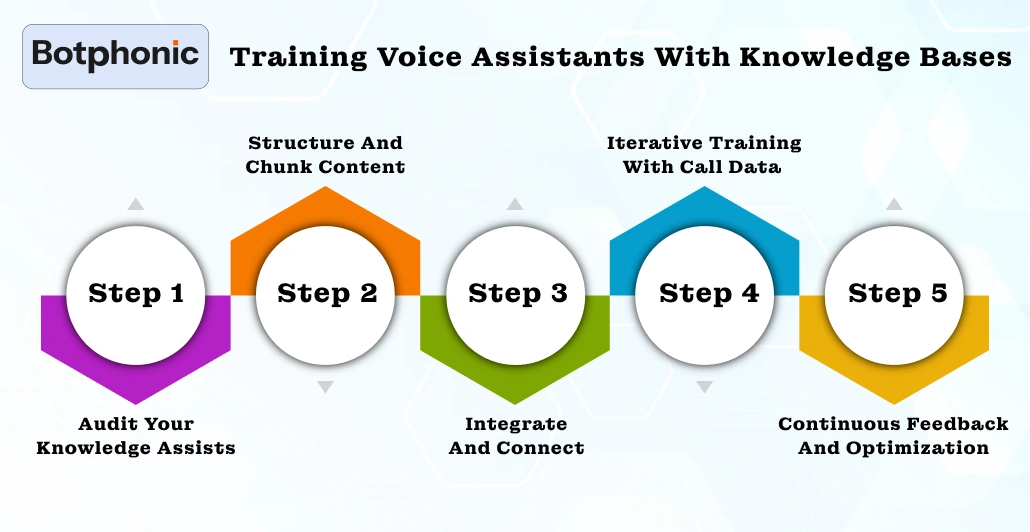
You have seen the result: Real-time suggestions. Context-aware responses and sub-second retrieval. But none of this is magic. Do you know what makes it happen? Training your AI on the right knowledge source makes it happen.
It doesn’t work like “let’s just upload some PDFs and see if it works.” A properly trained AI call assistant becomes smarter, faster, and more accurate with an optimally structured and iterative approach. Let’s see how:
Step 1: Audit Your Knowledge Assists
Start by charting of everything your agents are already using, such as:
- Policies, scripts, FAQs, product manuals, etc.
- Call transcripts and historical chat logs.
- Training guides and SOPs
Remove outdated, repetitive, and conflicting content from the bulk. Ensure only a clean, curated voice AI knowledge base is added so AI is not getting into any bad habits.
Step 2: Structure and Chunk Content
AI systems thrive on structure. Long documents or unformatted text usually slow the retrieval process and reduce accuracy.
- Break the content into bite-sized chunks, such as single policies, scripts, or FAQs per chunk.
- Add metadata, for instance, tags, categories, and intent labels, for faster and semantic search.
- Ensure to organize them by topic, call type, or customer scenario.
Proper chunking turns the massive knowledge base into a quick and actionable intelligence layer.
Step 3: Integrate and Connect
Now add your structured and organized knowledge into the AI platform. This process may involve:
- Connecting to existing KB platforms such as Confluence, Document360, etc.
- Uploading tailored content in a structured format.
- Charting internal taxonomies to AI-understood categories.
Now, from this stage onwards, the AI starts its learning relationships, hierarchies, and context from documentation.
Step 4: Iterative Training with Call Data
AI adapts and learns best from real-world examples:
- Use anonymized call transcripts to teach patterns of speech and phrasing.
- Include diverse accents, tones, and languages if relevant to the system.
- Annotate successful agent responses as “gold standard” answers.
These steps help AI to understand not just what to say but how to say it, and it makes calls feel natural in live calls.
Step 5: Continuous Feedback and Optimization
Training is not just a one-time event but a loop. You will have to:
- Monitor AI suggestions during live calls.
- Track accuracy, relevance, and agent adoption.
- Feed corrections and improvements regularly into the system.
Over time, your AI agent will become more confident, faster, and better aligned with the company’s tone, voice, and compliance requirements.
Implement your voice-first knowledge assistant in the call environment.
Contact Botphonic!!How AI Knowledge Assist Works (Under the Hood)
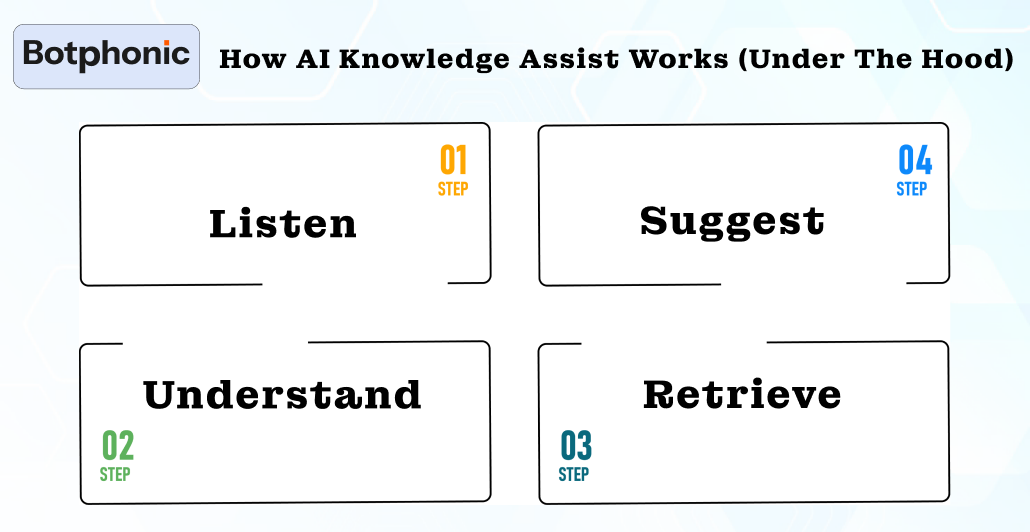
After exploring the concepts and training methods behind a voice AI knowledge base, we can now turn our attention to its process and see how it works magic.
The elementary operation can be summed up as Listen – Understand – Retrieve – Suggest.
The voice AI knowledge assistant commonly operates in four phases throughout a live call. Let’s discuss them shortly.:
1. Listen
The AI’s purpose is to permanently change oral words into written words with the help of a speech-to-text engine, and this is not just a simple transcription or typing of words, but the AI is also catching the most subtle details like the speaker’s pauses, stress, and choice of words, thus the real context is preserved.
2. Understand
Raw words are no longer effective. The AI now interprets intent and context behind the user’s words and then determines what the caller is asking.
For example: “I can’t access my account”, this issue might be referred to as a login issue, forgotten password, or just a locked account.
The AI will now weigh the context clues from previous conversation history and metadata to figure out which path it requires.
3. Retrieve
Once clarity of the intent is acquired, the system will then search the knowledge source, such as the internal KBs, policy documents, or transcripts, to share the most relevant information.
Modern systems are actively utilizing Retrieval-Augmented Generation (RAG):
1st best knowledge chunk is taken
Then the response is either summarized or synthesized.
This will ensure that AI is not just throwing documents towards the agent, but it’s delivering actionable and concise answers.
4. Suggest
Finally, the assistant offers the solution in a manner in which the agent can instantly make use of it. It’s normally via sidebar, overlay, or whisper prompt. It might:
- Suggest the next line of dialogue
- Offer other options that are ranked by confidence.
- Flag potential regulatory or compliance considerations.
And you should just know that all of this is happening in real time, often within seconds.
Overcoming Key Challenges When Training Voice AI with Knowledge
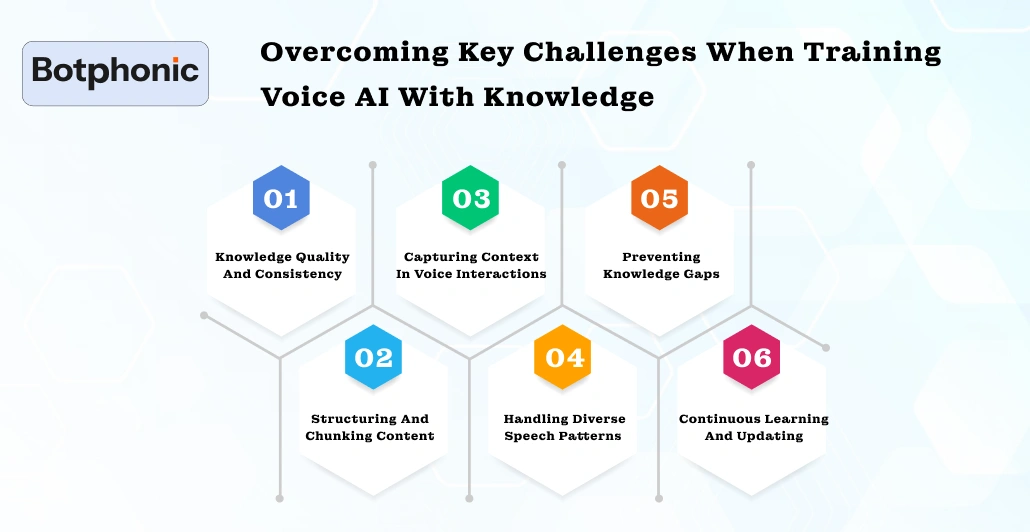
To create a yelling AI that can function as a nice call assistant with an enhanced AI customer service, it should become a challenging thing. And it’s not just about throwing a document into the system and hitting “start.” The secret is there are hurdles you might not have even imagined, but you can’t help it if you want the AI to give the right, timely, and contextually relevant suggestions.
1. Knowledge Quality and Consistency
The AI based on the quality of the information fed in is smart, otherwise it is dumb. A lot of companies have been operating with fragmented or outdated knowledge across the board, with conflicting policies, and even multiple versions of the same document.
Solution: Make it a point to perform a thorough audit to weed out the outdated or unnecessary material. Pick trustworthy sources and set a common structure for the AI to digest the information.
2. Structuring and Chunking Content
Long and dense documents make retrieval slow and mostly inaccurate due to their unstructured format.
Solution: Break information into smaller and meaningful chunks annotated with metadata. This will enable faster and context-aware retrieval during conversations.
3. Capturing Context in Voice Interactions
Unlike text, voice is continuous and nuance-filled. AI should retain context across multiple turns and be able to understand interruptions. Also, interpret the user’s tone or phrasing.
Solution: Implementing conversation windows and context embeddings that track the dialogue flow and ensure AI is remembering relevant information.
4. Handling Diverse Speech Patterns
Agents and customers speak vividly, in different accents, speech rates, colloquialisms, or sometimes even background noises can affect transcription.
Solution: Train your AI system on a variety of real-world audio samples, including diverse accents and speaking styles.
5. Preventing Knowledge Gaps
There will be times when not every query is available in the KB. If the AI is encountering any such situation, it may provide irrelevant answers or even hallucinate responses.
Solution: Ensure to integrate fallback protocols, confidence thresholds, and continuous learning loops, so AI can flag such uncertain cases and route them.
6. Continuous Learning and Updating
Knowledge is something that changes rapidly; without regular updates, AI can become outdated.
Solution: Set a review cycle to refresh content and retain the AI on new policies as well.
Empower your call agents today with instant AI intelligence.
Book a demo!!Real-World Impact: How AI Knowledge Assist Transforms Calls
Reading theory and getting to know it is good, but ROI speaks for itself. Let’s see how AI knowledge assistants are making a visible difference when applied to live interaction.
Telecom: Faster Resolutions Leading Happier Callers
Telecom agents often have to struggle with multiple tasks, such as plan changes, billing questions, and others. And that too, while the customers are just being too impatient.
With AI-assisted knowledge retrieval:
- Average handle time(AHT) drops significantly by 20-25%, as agents are getting instant access to a precise solution.
- Accuracy of answers improves over time, and AI call routing enhances escalations.
- Agents are guided through a multi-step workflow seamlessly.
And what are the results? It’s shorter calls, fewer errors, and customers who have actually finished the call happily. An AI customer service allows agents to focus on high-value clients while answering common queries of other clients.
Banking and Financial Services: Compliance Meets Efficiency
Financial agents often face a double challenge: fast service and strict regulatory compliance.
An AI knowledge assistant helps them by:
- Surfacing the regulatory clauses and verification scripts in real time.
- Reduces human error in compliance checks and documentation.
- Increases throughput: agents are now handling more calls without compromising quality.
Banks are getting measurable improvements in accuracy, operational efficiency, and risk mitigation.
Healthcare and Patient Support: Accurate, Empathetic Assistance
Healthcare agents are delivering correct information while keeping empathy front and center. Each mistake made here is costly in terms of trust and compliance.
AI knowledge retrieval enables:
- Quick and accurate recall of policies, procedures, and even coverage details.
- Consistent messaging across agents that ensures patients are receiving the same and accurate guidance.
- Reducing response time has made patients spend less time waiting and more time being helped.
During pilot implementation, patient satisfaction scores have increased noticeably, and agents have reported less stress.
Key Benefits of AI Knowledge Assist Across Industries
| Industry | Use Case / Scenario | Benefits |
| Telecom | Troubleshooting, plan changes, billing queries | Faster call resolution: 20–25% reduction in Average Handle Time (AHT) Improved accuracy: Fewer errors and callbacks Workflow guidance: Agents navigate complex processes seamlessly |
| Banking & Financial Services | Compliance checks, account verification, and regulatory guidance | Compliance assurance: Reduced human error in regulated processes Higher throughput: Agents handle more calls efficiently Risk mitigation: Real-time access to regulatory content |
| Healthcare / Patient Support | Policy inquiries, procedure explanations, coverage guidance | Consistent messaging: Same accurate info across all agents Faster response: Shorter wait times, improved patient experience Agent confidence: Reduced stress, improved decision-making |
What Makes Botphonic Different?
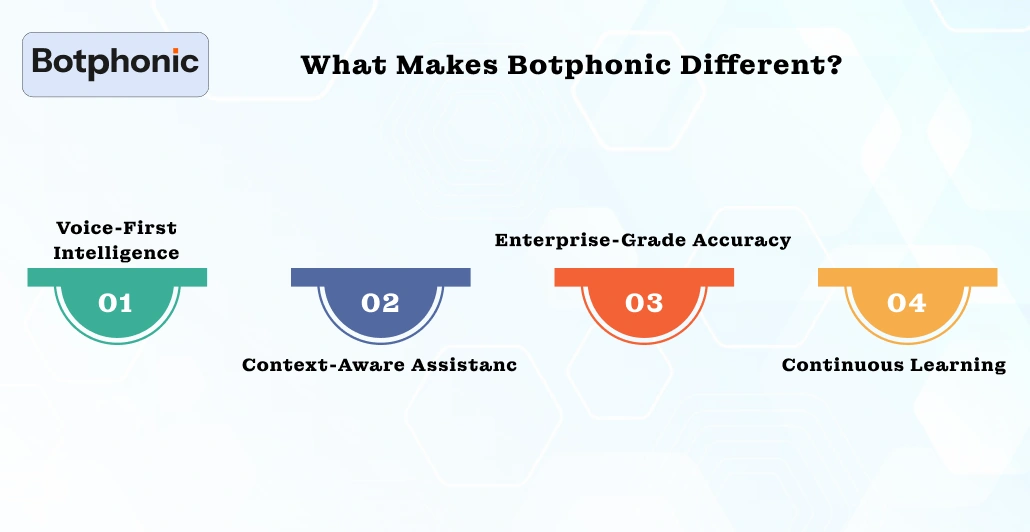
In this era of technology, there are several “AI assistants”, and they are just simple chatbots glorified for reading off static scripts. Botphonic has an enhanced voice AI knowledge base that helps in maintaining real conversations and never shares just a canned response.
Botphonic is designed with a clear purpose, and it’s to fill the gap between human intelligence and machine precision during live conversations. It doesn’t just respond to queries, but understands the context, interprets tone, and delivers actionable insights in real-time. Furthermore, it allows your agents to focus on the conversation, not on search.
With Botphonic, organizations are gaining:
- Voice-First Intelligence: Especially optimized for live call environments with sub-second knowledge retrieval.
- Context-Aware Assistance: Offers a dynamic understanding of customer intent and conversational flow.
- Enterprise-Grade Accuracy: Specifically trained based on your own verified knowledge sources, ensuring compliance and consistency.
- Continuous Learning: Evolves with every interaction and gets smarter with each interaction. Also, ensure to get aligned with the brand voice over time.
Basically, Botphonic is not here to replace your agents but to amplify them and enhance productivity overall. Turning every call into a high-precision and high-impact customer experience.
Conclusion
AI knowledge assistants are not something that you can negotiate with; they have proven themselves as a strategic imperative for modern call centers. Leveraging curated knowledge bases and iterative training, voice AI is now able to act as an invisible partner. Assisting agents in providing faster, smarter, and much more accurate answers, enabling increased CSAT.
Shorter calls are effectively resulting in happier customers and confident agents who can work through numerous queries while maintaining their role. With a trained voice AI that uses a proper knowledge base, there’s a measurable business impact across telecom, banking, and healthcare sectors.
